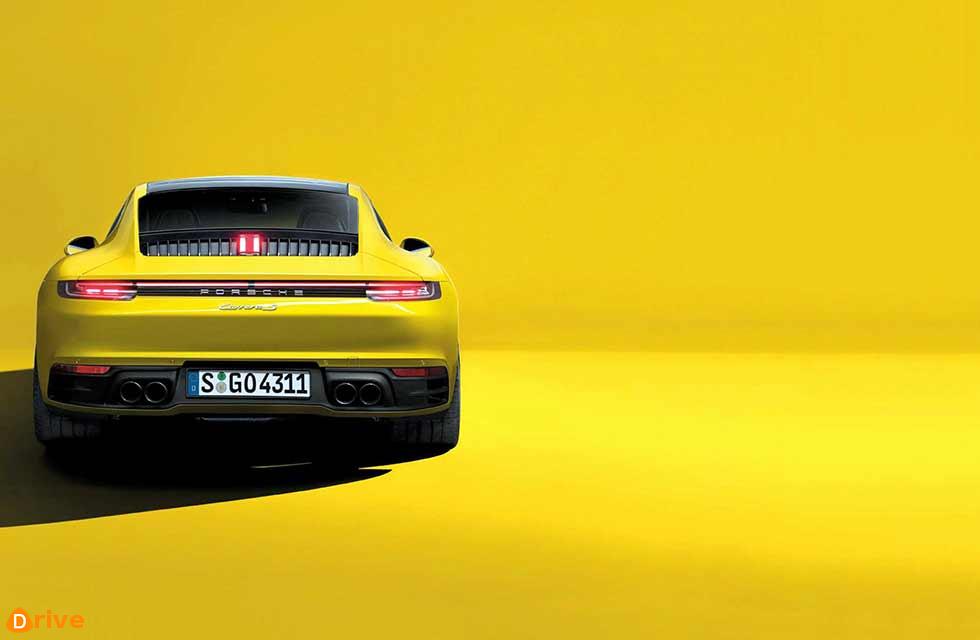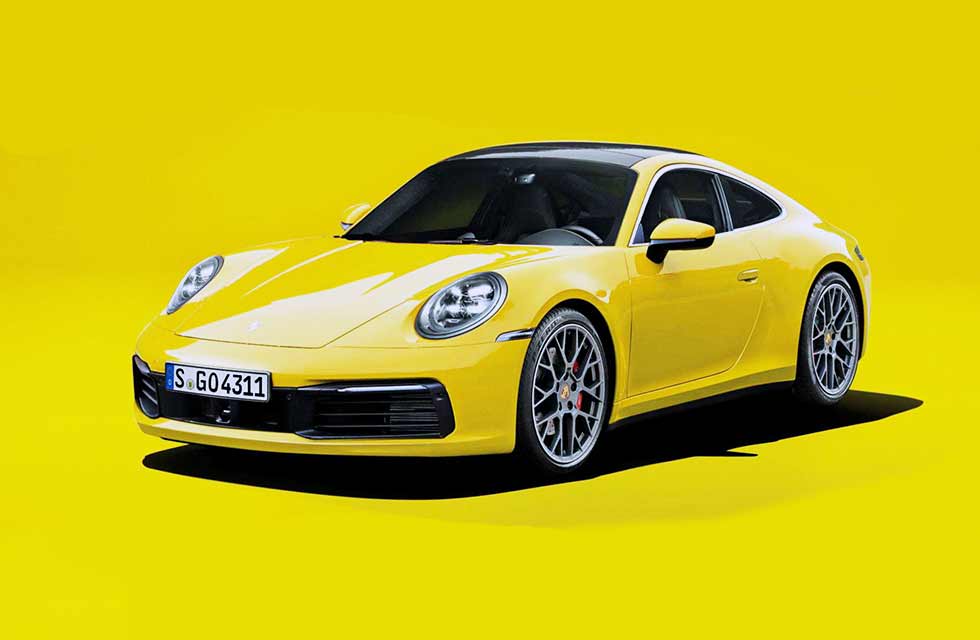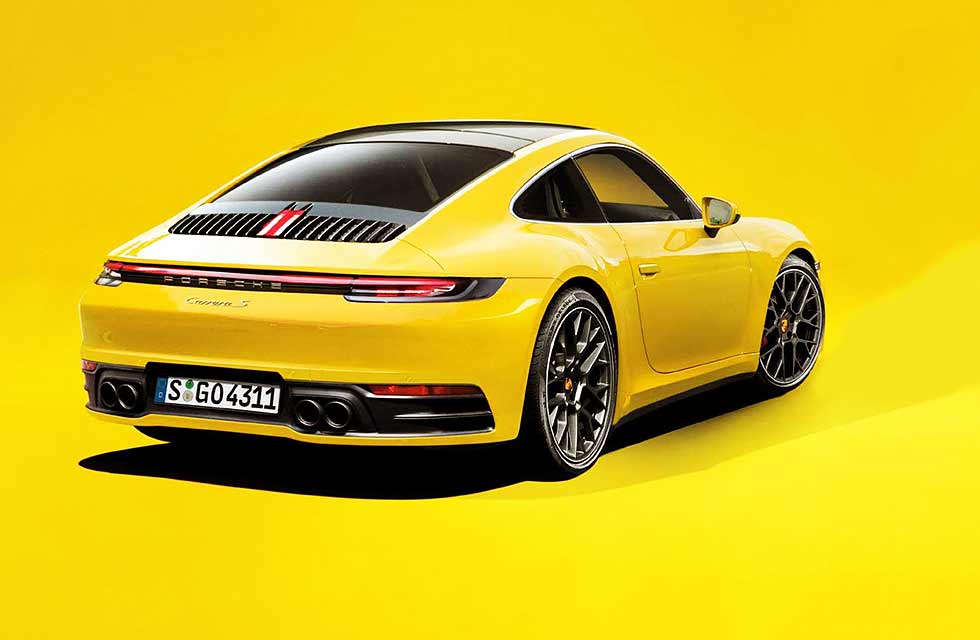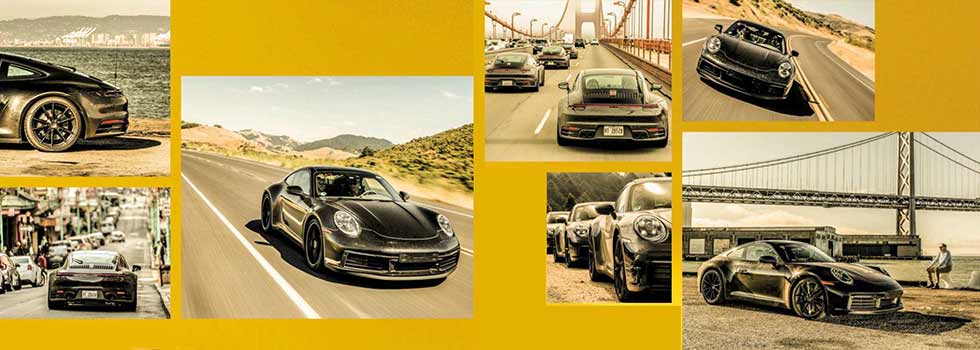911 Porsche’s high-tech hooligan – the all new 2019 Porsche 992 version of the ever-evolving 911 promises high-tech hooliganism like never before. It’s almost here – and we’ve had an early drive. Words Georg Kacher and Photography/illustrations Porsche & Avarvarii.
The new Porsche 911 We drive 2019’s 992 and reveal what makes it tick
THE EVER CHANGING CONSTANT
And straight down to business. There’s virtually no familiarisation required before you drive the new 911. It may be the most technically advanced version yet, designed with one eye on a likely future hybrid, but the 992 generation is very much the car we’ve known and loved for decades now. It looks like a 911, feels like a 911 – and drives like a sensationally good 911.

Sliding into the driver’s seat feels like putting on your favourite shoes: familiar, comfortable, ready for action. The primary controls are still in exactly the same position; the throttle response still keen to get going. The most obvious initial dynamic difference is the boost in power and torque, soon followed by the unexpectedly muffled exhaust note, which adds to the overall impression that everything’s a little smoother in the 992 than it was in the 991. It’s easy to start believing the new 911 is more cruiser than bruiser. Then the traffic clears and you discover that, as ever, the 911 has two co-habiting personalities: one that plays to the rules, and one that pulls out all the stops.

NOSE JOB Reshaped nose – with slightly longer bonnet and more built-in sensors – is more efficient at drawing in cooling air.
MORE MUSCLE Put it next to a 991 and the new generation is more muscular and heavier. There’s a hint of 993 in the screen and bonnet.
BIGGER RIMS Larger wheels host standard steel brakes on Carrera and bigger steels on the S; options include ceramic composites.
WHY OH WIDE? Full-width rear light strip, similar to Panamera’s, seems to serve no purpose beyond making it easier to spot a 992 at a glance.
WE ARE FAMILY Carrera 2S and 4S coupes arrive first, with cabrios close behind, then their non-S versions, then Turbo and GTS.
PANAMERA INSIDE Inside you’ll find a Panamera-inspired upgrade including big central touchscreen. Tacho is still analogue, mind.

So although the 911’s journey into the digital age has seen it pick up various fresh computer-controlled assets, it has arrived even faster, more efficient and, most of all, more fun to drive, as we’re discovering by testing a bunch of pre-production cars in the US several months before the real thing reaches the first buyers this winter.
There is still that charismatic flat-six hanging out aft of the rear axle, the same impossible weight distribution. The 992 is a thorough evolution of the preceding model, rather than a car that’s new down to the pores. After all, the 991 that’s about to be phased out is a remarkably inspiring and involving piece of kit. In tweaking the proven DNA, the emphasis was not on design and engineering but advanced ergonomics, new driver-assistance systems and further reduced emissions.
We’re driving in convoy through an area of northern California rich in corners, blind crests, spoiler-chewing dives, crumbling blacktop and hard shoulders that suddenly go soft. This is tough terrain for a fast car, and yet it feels like home turf for the 992, which is delivering the goods with verve. While the Carrera comes with 18-inch front and 19-inch rear wheels, the S is shod with 245/35 ZR20 front and 305/30 ZR21 rear Pirelli P Zeros. Grippy as they are, all hell would break loose if it weren’t for the disaster-prevention chips.
MUCH-IMPROVED FRONT-END BITE GIVES A BROADER SWEET SPOT AT THE LIMIT OF ADHESION
We’re joined by a passenger, Gustl Achleitner, R&D chief of the sports car division. ‘We are offering again a choice of transmissions, a seven-speed manual and a new eight-speed PDK [up from seven in the previous 911 auto ’box] which packages plug-in hybrid componentry should we ever decide to go that way…’ And will they? ‘We must prepare for all eventualities but weight and complexity remain tall hurdles.’
In the 991, the seven-speed ’box was a counter-productive fidgety-to-frustrating attempt to come to grips with the CO2 issue. In the 992, the shift quality has markedly improved, and that move from sixth into seventh is no longer a game of chance. But even the improved auto does not feel quite as slick and precise as the six-speed auto available in the current GT3. The optional rear-wheel steering is brilliantly effective.
Turn-in is even more reassuring now as lean and grip join forces, while steering and throttle establish a super-smooth handling balance. Without the rear-wheel steering, the new 911 feels rawer and edgier, but it also reveals a little more of its inherently tail-happy self. Our money would go into a manual car without the rear-steer, or a PDK variant with it.
After about an hour of hard driving, it feels like I’m fully on the Porsche’s wavelength. I’m in no doubt: this 911 moves in a more compliant yet more aggressive manner, it can handle a faster pace, and it hangs on quite a bit longer. Its biggest individual dynamic asset is the much-improved front-end bite, which allows for higher cornering speeds and a broader sweet spot at the limit of adhesion.
Achleitner confirms that I’m not imagining this: ‘The 992 builds up quantifiably more mechanical grip than the 991. The adjustable Bilstein dampers cover a broader range of action, the new passive engine mounts take the sting out of lift-off manouevres and the steering ratio is about five per cent quicker. Little things perhaps, but on aggregate they do make a difference.’ While the manual cars come with a mechanical locking diff, PDK models boast electronically controlled side-to-side torque distribution.
The exterior gives few clues about these mechanical and electrical developments. At a glance, the 992 is anything but a head-turner. But look closer and your eye is snagged by details like the contrasting black bumper inserts front and rear, the extra dose of Botox in all four wheelarches, the wider rims and the fancier three-part pop-up rear wing. More cooling air is now channelled to the brakes and the radiators via a slim horizontal intake, while the revised aero package neutralises lift. As is sadly in vogue these days, the tail lights have gone full-width for no real reason at all. The new car is 20mm longer and up to 40mm broader; it’s also 20kg heavier, due in part to those beefier wheels and trick rear wing.
The dashboard looks familiar, but it is in fact new. The central tacho still swings an analogue needle, and the ignition is still activated by key. But four of the five round dials are now digital, colourful, easily customisable and able to offer a lot of information. High up in the centre console lives a large rectangular display which invites you to zoom, scroll and swipe, just like in the current Cayenne and Panamera. The steering wheel controls can also keep your fingers busy, and then there are the shift paddles on PDK models and the three fat column stalks.
A well kitted-out 992 can do much more than accelerate swiftly, steer accurately and brake promptly. It can answer to the driver’s every dynamic whim by adjusting the damper action, the ESP mode or the throttle response. Tap the big screen, and five more options will pop up in a flash. They are labelled Wet, Normal, Sport, Sport Plus and Individual. Gone are the direct access buttons next to the gearlever, so every single menu and sub-menu needs to be opened via the main display – surely not a step in the right direction. Another issue concerns the tuning of the PDK ’box, which in Normal mode feels like it’s all about keeping emissions low – but then, when you switch to Sport or Sport Plus, you need to brace yourself for some high-revving hooliganism. For something so tech-heavy, its raw animal aggression is never far from the surface.
Porsche thought long and hard about the positioning of the Carrera 2 and Carrera 2S, eventually rating the lesser 3.0-litre engine at 380bhp, not the 395 we’d anticipated, while the S we drove is good for 444bhp. The twin-turbo unit is redlined at 7500rpm, maximum torque is a healthy 406lb ft, and fuel consumption is claimed not to have gone up, despite the addition of an energy-sapping particulate filter. With launch control activated, the PDK version can accelerate from zero to 62mph in a brisk 3.7sec. The top speed is 192mph, which should be plenty for most occasions. In a nutshell, the new Carrera S will be neck-and-neck with the outgoing, unfiltered GTS. The seventh-generation 911 directs more of its technology than ever in the pursuit of comfort and convenience. Thankfully it does so without compromising the core qualities that have made it such a legend.
THE 911 HAS ARRIVED IN THE DIGITAL AGE EVEN FASTER AND MORE FUN TO DRIVE






